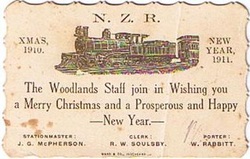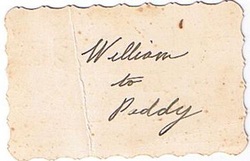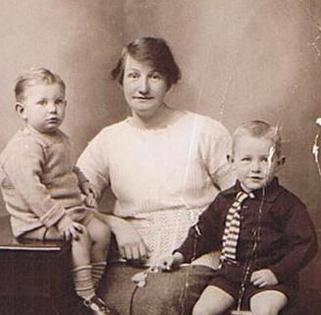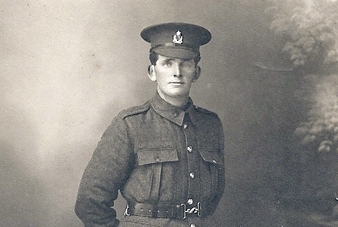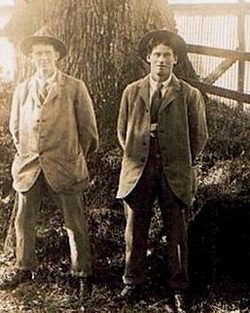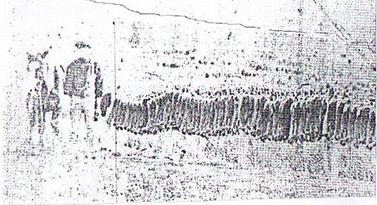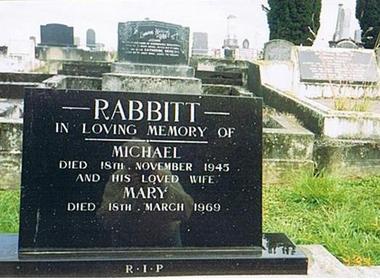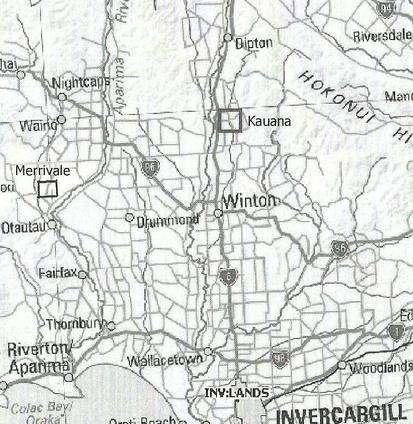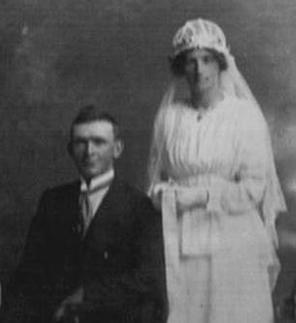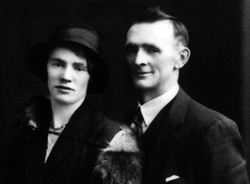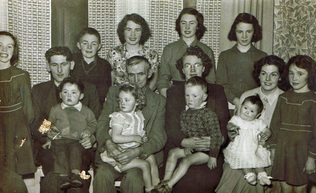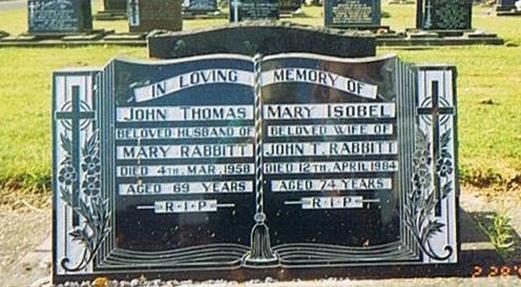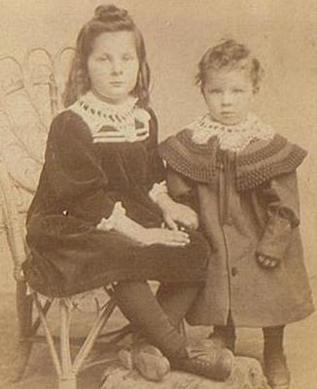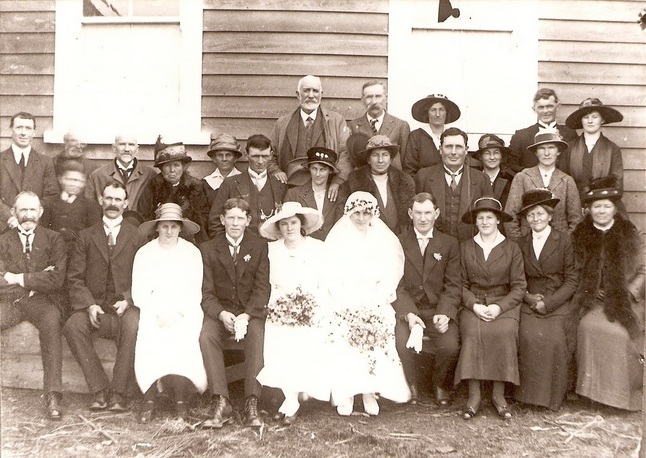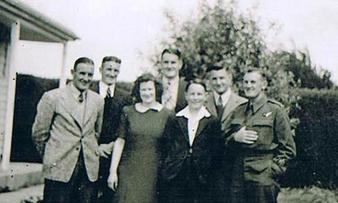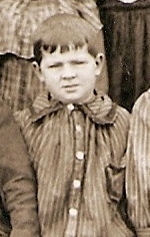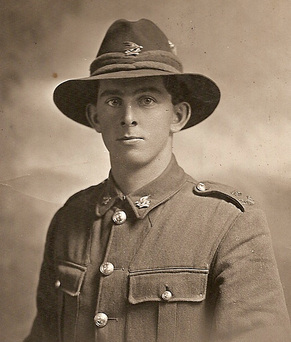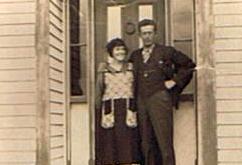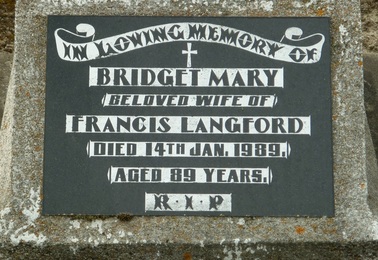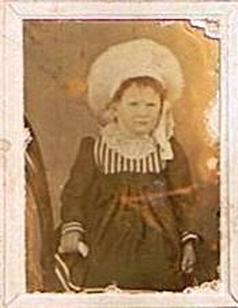The family of John Rabbitt and Mary Scully
Within the review, there are areas where the amount of information varies considerably, from person to person. This is because for some people there has been ample information available and difficult decisions have had to be made to omit material, whereas for others, the information has simply not been available. Should additional information become available on those whose lives and interests are only briefly explained, this work can be added to, to include the additional information. Below are some of the details available on the lives of the family of John Rabbitt and Mary Scully.
William Martin Rabbitt (1885 - 1941)

William was the first child of John and Mary (nee Scully), and he was born at Fernhills in 1885. It appears he was named after his grandfather; (William 1823 - 1897), and his father's brother, Martin Rabbitt, of Turloughmore, (1865 - 1932). The evidence is that throughout his life he was known as Bill.
Bill is recorded among the pupils who attended during the first decade at the Fernhills School. Initially Bill worked as a farmer in the Kauana district, however prior to 1909 he commenced work with the N.Z. Railways, and this was to continue for a large part of his working life. The proximity of the Railway Station, at Pukearuhe/Harringtons, probably provided the initial employment opportunity. It is known that by 1909 he was based with N.Z. Railways at Orepuki, and by 1910/11 he had moved to Woodlands. The following is the N.Z.R. Xmas card he sent to his brother in 1910/11. Note the name W.Rabbitt (Porter), on the bottom right of the card. Also shown is the handwriting which is on the reverse of the card; - this is included as an example of Bill's writing.
Bill is recorded among the pupils who attended during the first decade at the Fernhills School. Initially Bill worked as a farmer in the Kauana district, however prior to 1909 he commenced work with the N.Z. Railways, and this was to continue for a large part of his working life. The proximity of the Railway Station, at Pukearuhe/Harringtons, probably provided the initial employment opportunity. It is known that by 1909 he was based with N.Z. Railways at Orepuki, and by 1910/11 he had moved to Woodlands. The following is the N.Z.R. Xmas card he sent to his brother in 1910/11. Note the name W.Rabbitt (Porter), on the bottom right of the card. Also shown is the handwriting which is on the reverse of the card; - this is included as an example of Bill's writing.
There was evidently a break in the period of Bill's employment with N.Z. Railways, because by 1917, Bill was again described as a farmer of Kauana. About 1921, Bill married Annie Jane Timoney, of Invercargill, and the following are the details of their family of four;
John Patrick
Francis William (known as Tim)
Vincent Paul
Michael Joseph
The family lived at Eye Street, Invercargill from 1931 through to 1941, and during this time Bill's occupation is always given as a railway worker.
John Patrick
Francis William (known as Tim)
Vincent Paul
Michael Joseph
The family lived at Eye Street, Invercargill from 1931 through to 1941, and during this time Bill's occupation is always given as a railway worker.
Bill passed away on 2 November 1941, and his wife Annie passed away on 21 December, of the same year. They are buried at Invercargill.
Michael Rabbitt (1887 -1945)

Michael was the second child and second son of John and Mary Rabbitt. He was born at Fernhills on 20 November, 1887. Michael, who was usually known as Mick, was among the pupils who attended the Fernhills School during that school's first decade; 1883-1892.After finishing his schooling Michael worked as a farmer in the Kauana area. By July 1914 he had left the district to farm on land at Merrivale, that his father had bought.
The following is a extract from the Otautau Standard and Wallace County Chronicle of 7 July 1914.
The following is a extract from the Otautau Standard and Wallace County Chronicle of 7 July 1914.
|
On 19 February 1917, at age 29 years, he enlisted for military service in World War I. He enlisted at Invercargill. At the time of his enlistment, Michael's address was given as Kauana, and he was described as a self employed farmer. The medical examination on enlistment shows the following personal details;
Height: 5ft 7 1/4inches Weight: 135lbs Complexion: Fresh Eyes: Grey Hair: Brown Religion: Roman Catholic Michael began his military training in New Zealand, and left for overseas service on the vessel "TAHITI", which departed from Wellington on 12 June 1917. He disembarked at Devonport, England, on 16 August 1917, and was posted to the Otago Company based at Sling, a large military training establishment in the south of England. |
After 2 months further training at Sling, Michael left England for active service in France. He travelled to France on 26 October 1917, and was posted to "8" Company at Etaples. He was promoted to Lance Corporal on 8 June 1918, however two months later on 9 August 1918 he was returned to England due to ill health - pneumonia and appendicitis. Michael was treated in the military hospital at Brocklehurst, and was not discharged until 14 November 1918.
(The war ended on the 11 November 1918, and Michael did not return to France.)
As Michael did not leave England for his return to New Zealand until 24 December 1918, there was a six week opportunity for him to visit family in Ireland. This opportunity appears to have been taken. In a letter from London, to family in New Zealand, Martin (Mattie) Rabbitt; (a first cousin of Michael's), recalled a NZ serviceman named Michael Rabbitt and James Chamberlain visiting his family in Ireland, at the end of World War I.
(The war ended on the 11 November 1918, and Michael did not return to France.)
As Michael did not leave England for his return to New Zealand until 24 December 1918, there was a six week opportunity for him to visit family in Ireland. This opportunity appears to have been taken. In a letter from London, to family in New Zealand, Martin (Mattie) Rabbitt; (a first cousin of Michael's), recalled a NZ serviceman named Michael Rabbitt and James Chamberlain visiting his family in Ireland, at the end of World War I.
Michael arrived back in New Zealand on 30 January, 1919, and was discharged from military service on 18 April 1919. In recognition of his service, he received the British War Medal, and the Victory Medal.
On his return Michael resumed his farming life in the Kauana district and in 1922 he married Mary Going of Invercargill. Mary’s parents were farming in the Fernhills district.
On his return Michael resumed his farming life in the Kauana district and in 1922 he married Mary Going of Invercargill. Mary’s parents were farming in the Fernhills district.
Michael and Mary farmed in the Kauana/Pukearuhe area adjacent to the area farmed by his uncle and father. The specific area of land farmed by Michael is shown below:
There are stories of Michael's skill in the catching rabbits, and a photo exists of Michael displaying a catch of over 100 rabbits - the result of one nights work! Unfortunately the photo has now faded but it is still reproduced for this review because it is something "special". Another story told about Michael's rabbiting skills is that his father (John) was able to fund a return trip to Ireland, solely from the sale of the rabbit’s!!
There are recollections within the family of Michael and Mary’s original home being burnt down.
Michael and Mary (nee Going), and had 2 children. They were,
Maurice Leo
Winifred Eleanor
Michael and Mary lived in the Kauana district and were involved in supporting many district activities. For 25 years Michael was the secretary of the local Community Hall. Michael was also involved as treasurer of the Pukearuhe Athletic Society - see the poster in the appendices which was produced to support the second annual gathering of the society in 1922. Note that the gathering was "held on the grounds of Mr Rabbitt, Pukearuhe". It is unclear which Mr Rabbitt is referred to, as Michael's uncle William Rabbitt; (1873 - 1938), was also on the committee of the society, and of course both Michael and William owned land in the Pukearuhe area. The poster is also useful as an aid to historians of the Kauana district at that time, as it is a "who's who" of the district's residents. Names like Cowan, Murphy, Anderson, and Rabbitt had a long association with the district.
Michael died on 18 November 1945, just two days prior to his 58th birthday.
After Michael's death, his wife, Mary (nee Going), lived at Invercargill and Winton, and she passed away on 18 March 1969.
Michael and Mary (nee Going), and had 2 children. They were,
Maurice Leo
Winifred Eleanor
Michael and Mary lived in the Kauana district and were involved in supporting many district activities. For 25 years Michael was the secretary of the local Community Hall. Michael was also involved as treasurer of the Pukearuhe Athletic Society - see the poster in the appendices which was produced to support the second annual gathering of the society in 1922. Note that the gathering was "held on the grounds of Mr Rabbitt, Pukearuhe". It is unclear which Mr Rabbitt is referred to, as Michael's uncle William Rabbitt; (1873 - 1938), was also on the committee of the society, and of course both Michael and William owned land in the Pukearuhe area. The poster is also useful as an aid to historians of the Kauana district at that time, as it is a "who's who" of the district's residents. Names like Cowan, Murphy, Anderson, and Rabbitt had a long association with the district.
Michael died on 18 November 1945, just two days prior to his 58th birthday.
After Michael's death, his wife, Mary (nee Going), lived at Invercargill and Winton, and she passed away on 18 March 1969.
John Thomas Rabbitt (1888 - 1958)
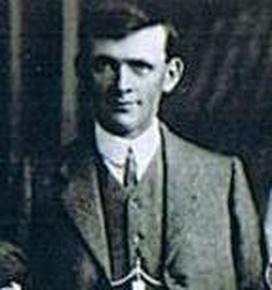
John was the third child and third son of John and Mary (nee Scully). He was born at Fernhills on 25th June 1888 and presumably he was named after his father.
There is an interesting aspect to John's second given name of "Thomas", which merits recording here. It is believed John's birth was registered with only one given name however at the time of his church confirmation John took a second given name - Thomas. This second name is understood to have been in memory of a younger brother (named Thomas) who died in 1899, aged only one day. All subsequent official documents refer to his name as John Thomas Rabbitt.
John, who was always known as Jack, is recorded among the pupils who attended the Fernhills School during that school's first decade; (1883 - 1892.) After completing his education, he lived in the Kauana district where, along with other members of the family, he learnt the skills of farming from his father.
In 1913, while still living at Kauana, Jack was taken seriously ill with appendicitis. This illness occurred at the time of major flooding in the Southland area and Jack had to be rowed across the flooded Oreti River before he could reach the public hospital in Invercargill. By the time this was done his appendicitis had become peritonitis and Jack was very lucky to survive. But survive he did, only to be laid low by clots in his legs that were a result of the total illness. Because of this illness he was judged unfit for National Service and so missed the service in World War I, for which some of his brothers enlisted.
About 1915, Jack purchased the land at Merrivale, near Orawia, in Western Southland, which was to be the focus of his working life for more than 30 years. This land was situated about 40 miles from the Fernhills/Kauana district where his father had become so well established and where his brothers were to set up their own land. (The following map shows the area of Merrivale/Orawia in relation to the Fernhills/Kauana area, and one can only speculate as to the reasons this particular area was chosen.)
There is an interesting aspect to John's second given name of "Thomas", which merits recording here. It is believed John's birth was registered with only one given name however at the time of his church confirmation John took a second given name - Thomas. This second name is understood to have been in memory of a younger brother (named Thomas) who died in 1899, aged only one day. All subsequent official documents refer to his name as John Thomas Rabbitt.
John, who was always known as Jack, is recorded among the pupils who attended the Fernhills School during that school's first decade; (1883 - 1892.) After completing his education, he lived in the Kauana district where, along with other members of the family, he learnt the skills of farming from his father.
In 1913, while still living at Kauana, Jack was taken seriously ill with appendicitis. This illness occurred at the time of major flooding in the Southland area and Jack had to be rowed across the flooded Oreti River before he could reach the public hospital in Invercargill. By the time this was done his appendicitis had become peritonitis and Jack was very lucky to survive. But survive he did, only to be laid low by clots in his legs that were a result of the total illness. Because of this illness he was judged unfit for National Service and so missed the service in World War I, for which some of his brothers enlisted.
About 1915, Jack purchased the land at Merrivale, near Orawia, in Western Southland, which was to be the focus of his working life for more than 30 years. This land was situated about 40 miles from the Fernhills/Kauana district where his father had become so well established and where his brothers were to set up their own land. (The following map shows the area of Merrivale/Orawia in relation to the Fernhills/Kauana area, and one can only speculate as to the reasons this particular area was chosen.)
That occupancy of the land at Merrivale had been established by May 1915, is proven by the following account, from an Orawia storekeeper, to John Rabbitt, dated May 1915. Full details of these accounts are shown in the appendices.
While living and working at Merrivale, Jack met Catherine Chamberlain, and they were married about 1917.
The following photograph shows them on their wedding day.
The following photograph shows them on their wedding day.
Jack and Catherine Rabbitt (nee Chamberlain), had two children;
Maureen
Desmond
Ill health again dogged Jack's life, when his wife Catherine became ill with tuberculosis. (As will be seen from later in this review Catherine was another member of this wider family to be affected by the tuberculosis problem in the community at this time.) In 1930, Catherine passed away from this illness, and Jack left her grave with a very young child on each hand. Maureen was 9 years of age and Desmond was only 3 years old. Below left is the death notice which appeared in the Otautau Standard and Wallace County Council Chronical on the 11 March 1930.
Maureen
Desmond
Ill health again dogged Jack's life, when his wife Catherine became ill with tuberculosis. (As will be seen from later in this review Catherine was another member of this wider family to be affected by the tuberculosis problem in the community at this time.) In 1930, Catherine passed away from this illness, and Jack left her grave with a very young child on each hand. Maureen was 9 years of age and Desmond was only 3 years old. Below left is the death notice which appeared in the Otautau Standard and Wallace County Council Chronical on the 11 March 1930.
|
There were 8 children of this marriage;
Winifred Ellen Joan Mary Patricia Isla John Dennis Teresa Margaret Mary Magdalen Douglas Michael Pauline Anne |
During the 2nd World War, when building permits were not granted, Jack had a need to expand his home to accommodate his growing family, and his solution was to cover the tennis court with a wooden floor, build a frame over which he slung a tent, and he covered the canvas with tar stained sacks. His daughters, Win, Joan, and Pat, in particular have fond memories of sleeping in this tent .......... the cows always seemed nearer!! Gates left open could be an open invitation and waking up to the sight of cows was an experience not to be missed........neither were the consequences!!
Years of working a farm with little or no help during two World Wars and the Great Depression, as well as indifferent health, and the loss of his first wife, took their toll on Jack, but they also made him into a very strong man. In depressed times he was able to fight officialdom, and save his farm, and stories abound of how an Otautau bank manager felt the full strength of Jack's character and determination.
Jack had a great love of sport - in his youth he was a boxer and won a medal for it. In his later years he enjoyed playing bowls. He enjoyed his family’s participation in sport, particularly tennis and rugby, and he kept records of their achievements. Family members remember being told of how many goals were missed, before being told of their successes!
In 1949 Jack's failing health meant a major change for the family. While still retaining the farm at Merrivale, the family moved to Invercargill where Jack spent the last years of his life. His strength of character was to help him through his last days, when sickness and strokes left him paralysed, and he depended on his wife Mary, for everything.
He died surrounded by his family on 4 March 1958, just three months before his 70th birthday, and 5 months before he and Mary could celebrate their silver wedding anniversary.
Jack's wife Mary (nee Donaghy), survived Jack by 26 years and she died on 12 April 1984. They are buried at the Invercargill Cemetery.
The following is a photograph of the headstone over their grave.
Eugene Rabbitt (1890 - 1904)

Eugene was the fourth son of John and Mary Rabbitt, and he was born at Fernhills in 1890. The above photograph of Eugene was taken when he was about 2 or three years of age.
Initially the choice of Eugene as the given name appeared unusual as no other occurrences of the name had occurred within the family; - however the choice of name was explained when it was learnt that, in Ireland, the names of “Eugene” and “Owen’ were often inter-changeable. Eugene’s maternal grandfather, that is the father of Mary Rabbitt nee Scully, was named Owen Scully.
Eugene attended the Fernhills School and the understanding within the family is that he was an extremely clever student. There exists a school exercise book that was used by Eugene when he was a Standard 7 student, in 1903.
Initially the choice of Eugene as the given name appeared unusual as no other occurrences of the name had occurred within the family; - however the choice of name was explained when it was learnt that, in Ireland, the names of “Eugene” and “Owen’ were often inter-changeable. Eugene’s maternal grandfather, that is the father of Mary Rabbitt nee Scully, was named Owen Scully.
Eugene attended the Fernhills School and the understanding within the family is that he was an extremely clever student. There exists a school exercise book that was used by Eugene when he was a Standard 7 student, in 1903.
A study of the exercise book shows Eugene was an extremely bright student completing work, that even 90 years later, students of a similar age (12/13 years), would be fully tested by. The subjects Eugene studied included; Arithmetic, Latin, Book-keeping and Geography. (Examples of pages from this school exercise book are included in the appendices to this review.)
Early in 1904, Eugene became ill, and he was admitted to hospital in Invercargill. Included in the appendices is a photocopy of a letter written by him, from hospital, to his older brother Jack; - (John Rabbitt 1888- 1958).
Tragically, just three weeks after this letter was written, Eugene died while still in hospital, in Invercargill. He died on 26 March 1904, aged 13 years. The official cause of death is given as “Brights Disease”, which is also known as nephritis - inflammation of the kidneys.
The cause of death also states “3 1/2 months syncope”, which means “fainting, loss of consciousness from fall of blood pressure.”
Eugene was buried in the Rabbitt family plot at the Winton Cemetery, on the 29 March 1904.
Early in 1904, Eugene became ill, and he was admitted to hospital in Invercargill. Included in the appendices is a photocopy of a letter written by him, from hospital, to his older brother Jack; - (John Rabbitt 1888- 1958).
Tragically, just three weeks after this letter was written, Eugene died while still in hospital, in Invercargill. He died on 26 March 1904, aged 13 years. The official cause of death is given as “Brights Disease”, which is also known as nephritis - inflammation of the kidneys.
The cause of death also states “3 1/2 months syncope”, which means “fainting, loss of consciousness from fall of blood pressure.”
Eugene was buried in the Rabbitt family plot at the Winton Cemetery, on the 29 March 1904.
Mary Rabbitt (1892-1893)
Mary was the fifth child and the first daughter of John and Mary Rabbitt. She was born at Fernhills, in December 1892, and presumably she was named after her mother.
Mary died on 7 July 1893, aged 8 months, and the official cause of her death is given as "teething troubles". As Mary was their first daughter, after 4 sons, her death would have been keenly felt by her parents. She was the first person to be buried in the Rabbitt family plot at the Winton Cemetery, and her burial occurred on 9 July 1893.
Mary died on 7 July 1893, aged 8 months, and the official cause of her death is given as "teething troubles". As Mary was their first daughter, after 4 sons, her death would have been keenly felt by her parents. She was the first person to be buried in the Rabbitt family plot at the Winton Cemetery, and her burial occurred on 9 July 1893.
Nora Anne Rabbitt (usually known as Nonie) (1894 -1969)

Nora was the sixth child and second daughter of John and Mary Rabbitt, and she was born at Fernhills in 1894. It seems most likely Nora was named after her mother’s mother, Honora Scully (nee Hennelly), of Galway in Ireland. The evidence is that from a very young age, Nora was usually referred to as; Nonie and this name is used is this review.
The following photograph of Nonie was taken about 1898, when she would have been about 4 years of age.
The following photograph of Nonie was taken about 1898, when she would have been about 4 years of age.
Nonie is recorded among the pupils who first attended Fernhills School during its second decade, (1893-1902); and she would have attended that school until at least until well into its third decade.
Nonie was just 12/13 years of age when her mother passed away in June 1907, and as the oldest daughter, it can be presumed she then carried extra responsibilities - particularly in helping with younger family members. Nonie continued to live with the family at Kauana through her teenage years and there is evidence of her living in the district up to 1918, through postcards sent to her from her two brothers on overseas military service - Michael and Patrick.
The following picture of Nonie is estimated to have been taken in 1913, at which time she would have been about 19 years of age.
Nonie was just 12/13 years of age when her mother passed away in June 1907, and as the oldest daughter, it can be presumed she then carried extra responsibilities - particularly in helping with younger family members. Nonie continued to live with the family at Kauana through her teenage years and there is evidence of her living in the district up to 1918, through postcards sent to her from her two brothers on overseas military service - Michael and Patrick.
The following picture of Nonie is estimated to have been taken in 1913, at which time she would have been about 19 years of age.
On the 28 August 1918, Nonie married Thomas Ryan from Limehills. Their marriage occurred at the Sacred Heart Church in Centre Bush. Thomas Ryan was aged 27 years, and he was born at Caher in County Tipperary, Ireland; - his parents were Edmund and Bridget Ryan, nee Prendergast.
Above is a particularly significant photo as it is one of only two sighted which puts members of the family of the original three Rabbitt brothers together at the same location. Rabbitt family members included in the above photo are;
Back row, (second from right) William Rabbitt of Kauana (Bride’s brother)
(extreme right) Mary Rabbitt of Wairuna (Bride’s cousin)
Middle row, (six from right) John Thomas Rabbitt of Merrivale (Bride's brother)
(seven from right) Catherine Rabbitt of Merrivale (Wife of John Thomas Rabbitt)
(extreme right) Norah Rabbitte of Harringtons (Bride’s aunt - wife of William Rabbitte)
Front row, (extreme left) John Rabbitt of Kauana (Bride's father)
(2nd from left) William Rabbitte of Harringtons (Bride’s uncle)
(3rd from left) Winifred Rabbitt of Kauana (Bride's sister)
(5th from left) Bridget Rabbitt of Kauana (Bride's sister)
On the right of bridegroom Kate Rabbitt of Wairuna (Bride's cousin)
(2nd from right) Norah Rabbitt of Wairuna (Bride's aunt - wife of Patrick Rabbitt)
The wedding occurred 34 years to the day, after the wedding of the bride’s parents, John and Mary Rabbitt, (nee Scully). The witness’ at the wedding were; Martin Hardiman of Limehills and Bridget Rabbitt (the bride’s sister).
Back row, (second from right) William Rabbitt of Kauana (Bride’s brother)
(extreme right) Mary Rabbitt of Wairuna (Bride’s cousin)
Middle row, (six from right) John Thomas Rabbitt of Merrivale (Bride's brother)
(seven from right) Catherine Rabbitt of Merrivale (Wife of John Thomas Rabbitt)
(extreme right) Norah Rabbitte of Harringtons (Bride’s aunt - wife of William Rabbitte)
Front row, (extreme left) John Rabbitt of Kauana (Bride's father)
(2nd from left) William Rabbitte of Harringtons (Bride’s uncle)
(3rd from left) Winifred Rabbitt of Kauana (Bride's sister)
(5th from left) Bridget Rabbitt of Kauana (Bride's sister)
On the right of bridegroom Kate Rabbitt of Wairuna (Bride's cousin)
(2nd from right) Norah Rabbitt of Wairuna (Bride's aunt - wife of Patrick Rabbitt)
The wedding occurred 34 years to the day, after the wedding of the bride’s parents, John and Mary Rabbitt, (nee Scully). The witness’ at the wedding were; Martin Hardiman of Limehills and Bridget Rabbitt (the bride’s sister).
|
Nonie and Thomas Ryan had a family of seven; - six sons and one daughter. The members of their family were;
Edmund John Thomas Kevin Michael Bernard Patrick Joseph Paul Anthony Mary Bridget William |
It will be noted the familiar Rabbitt family given names of; John, Michael, Patrick, Paul, Mary and William, are all reappearing in this branch of the family.
The family lived in the Invercargill area, and the following photograph of Nonie was taken in 1958, at the 85th Jubilee Celebrations of the Fernhills School.
Nonie's husband Thomas Ryan died on 6th June 1956.
Nonie survived her husband by 13 years and she passed away at Invercargill on 14 June 1969, - aged 75 years.
Above right is a photograph of the headstone over their grave.
Nonie survived her husband by 13 years and she passed away at Invercargill on 14 June 1969, - aged 75 years.
Above right is a photograph of the headstone over their grave.
Patrick James Rabbitte (1896 - 1962)

Patrick was the seventh child and fifth son of John and Mary Rabbitt (nee Scully). He was born on 13th November 1896. Patrick may have been named after his uncle, Patrick (1858 - 1924) who lived at Wairuna, and who is referred to in the section "The First Generation in New Zealand".
It appears that in the early years of his life, Patrick was known as "Jim". As his second name was James, this was not uncommon, but at a later stage of his life, Patrick became known as "Paddy". School records and early correspondence always refer to him as Jim, but by the 1920's he was known as Paddy. (For the purpose of this review he will be referred to throughout by his first given name - Patrick.)
Like all his brothers and sisters Patrick attended school at Fernhills.
It appears that in the early years of his life, Patrick was known as "Jim". As his second name was James, this was not uncommon, but at a later stage of his life, Patrick became known as "Paddy". School records and early correspondence always refer to him as Jim, but by the 1920's he was known as Paddy. (For the purpose of this review he will be referred to throughout by his first given name - Patrick.)
Like all his brothers and sisters Patrick attended school at Fernhills.
The next record of Patrick is in 1917 when at the age 20 years and 4 months he enlisted for military service in World War I. He enlisted in Invercargill on 17th March 1917, (St. Patrick's Day).
Personal details given at the time of enlistment show;
Height 5 feet 5 1/2 inches
Weight 9 stone 9 pounds
Complexion Fresh
Eyes Blue
Hair Black
Religion Roman Catholic
Next of Kin (i) J Rabbitt, Kauana (father)
(ii) Father Rabbitt, Mt. St. Joseph's Abbey, Roscrea, County Tipperary, Ireland. *
Occupation Farmer
Employer J Rabbitt **
Address Post Office, Maryville.
* This is interesting, as given the number of New Zealand relatives available to be listed as an alternate next of kin, Patrick chose to name his uncle (Father Paul) in Ireland.
** Note that Patrick's employer was his older brother, John Thomas Rabbitt, who farmed at Merrivale (Maryville) in Southland, about 40 miles from Kauana. Therefore by at least 17 March 1917 and probably earlier than that, Patrick had left the Kauana district, and was employed by his brother at Merrivale.
Patrick's military service record commenced at Trentham Camp (near Wellington), on 15 September 1917. Later as a member of the Canterbury Mounted Rifles he was based at the Military Camp at Featherston. On 21 February 1918, Trooper Patrick Rabbitte departed New Zealand on board the "Moeraki". At Sydney, he transhipped to the "Ormonde" and travelled on to Suez, Egypt; where he arrived on 4 April 1918. While in Egypt/ Palestine he served at Moascar, Abbassia and Ismalia.
Height 5 feet 5 1/2 inches
Weight 9 stone 9 pounds
Complexion Fresh
Eyes Blue
Hair Black
Religion Roman Catholic
Next of Kin (i) J Rabbitt, Kauana (father)
(ii) Father Rabbitt, Mt. St. Joseph's Abbey, Roscrea, County Tipperary, Ireland. *
Occupation Farmer
Employer J Rabbitt **
Address Post Office, Maryville.
* This is interesting, as given the number of New Zealand relatives available to be listed as an alternate next of kin, Patrick chose to name his uncle (Father Paul) in Ireland.
** Note that Patrick's employer was his older brother, John Thomas Rabbitt, who farmed at Merrivale (Maryville) in Southland, about 40 miles from Kauana. Therefore by at least 17 March 1917 and probably earlier than that, Patrick had left the Kauana district, and was employed by his brother at Merrivale.
Patrick's military service record commenced at Trentham Camp (near Wellington), on 15 September 1917. Later as a member of the Canterbury Mounted Rifles he was based at the Military Camp at Featherston. On 21 February 1918, Trooper Patrick Rabbitte departed New Zealand on board the "Moeraki". At Sydney, he transhipped to the "Ormonde" and travelled on to Suez, Egypt; where he arrived on 4 April 1918. While in Egypt/ Palestine he served at Moascar, Abbassia and Ismalia.
Late in November 1918, after peace had been declared, Patrick was among some 500 officers and men of the Canterbury Mounted Rifles, who went to the Gallipoli Peninsula to ensure the Turks were complying with the terms of the armistice. Visits were made to old battlefields at Anzac and burials were completed for those killed in the battles there. Photographs exist which indicate Patrick was among the NZ servicemen who were at Gallipoli at the end of WWI.
After his time at Gallipoli, Patrick travelled to the United Kingdom, arriving there in late May 1919. He stayed there for two months, prior to his departure for New Zealand. During this time; (June/July 1919), he took the opportunity to visit family members in Ireland. He met with his uncle Timothy Rabbitt - (Father Paul); at the monastery at Roscrea and photographs exist which prove that he met with other members of the family at Turloughmore in Galway,
Patrick returned to New Zealand on the vessel "Hororata" departing from Plymouth on July 18th, 1919; and disembarking on 23rd September 1919. For his military service he received the British War Medal and the Victory Medal.
After his return to New Zealand it is believed Patrick lived and worked in the Kauana district until at least 1921. Included in the appendices is a letter written to Patrick from his uncle Father Paul, of the Mount St. Joseph Abbey in Roscrea in Ireland. This letter dated 12 July 1921, indicates it is part of a continuing correspondence between them and it discusses their shared interest in events in Ireland at that time - the attempt by the Irish to establish complete independence from England. The 1928 Electoral Rolls show Patrick working as a farm labourer in the Tauranga area, where his cousin William Rabbitt was also living.
Patrick was again farming at Fernhills by 1929. Patrick owned land on the other side of the Winton/Dipton road, from that of his father and brother. At some stage a house was built on this land. The following local area map shows the extent of the Rabbitt family in this community by the 1930's.
Patrick returned to New Zealand on the vessel "Hororata" departing from Plymouth on July 18th, 1919; and disembarking on 23rd September 1919. For his military service he received the British War Medal and the Victory Medal.
After his return to New Zealand it is believed Patrick lived and worked in the Kauana district until at least 1921. Included in the appendices is a letter written to Patrick from his uncle Father Paul, of the Mount St. Joseph Abbey in Roscrea in Ireland. This letter dated 12 July 1921, indicates it is part of a continuing correspondence between them and it discusses their shared interest in events in Ireland at that time - the attempt by the Irish to establish complete independence from England. The 1928 Electoral Rolls show Patrick working as a farm labourer in the Tauranga area, where his cousin William Rabbitt was also living.
Patrick was again farming at Fernhills by 1929. Patrick owned land on the other side of the Winton/Dipton road, from that of his father and brother. At some stage a house was built on this land. The following local area map shows the extent of the Rabbitt family in this community by the 1930's.
In 1939 Patrick married Eileen Sinclair, of Benmore. Eileen was the daughter of Samuel and Isabella Sinclair of Invercargill.
After their marriage Patrick and Eileen farmed the land at Fernhills, where two of their five children were born. By 1941, Patrick had become another family member to be affected by the tuberculosis epidemic that affected many within the Rabbitt family. Shortly after the birth of the second daughter, he was admitted as a long term patient to the Sanatorium at Waipiata in Central Otago. Patrick was at Waipiata for seven years, with occasional visits to his family, who had moved from Fernhills to live in Invercargill. Patrick was discharged from Waipiata in 1948 and he then lived in retirement, with his family at the Sydney Street address in Invercargill.
Patrick and Eileen (nee Sinclair), had a family of four daughters and one son. Details of their family are;
Eileen Mary
Elizabeth Veronica
Brian Patrick James
Kathleen Isabella
Anne (born 1955 - died aged 1 day)
In his retirement, Patrick enjoyed working in his very large garden at the Invercargill address. He also spent time making moccasins and working with leather, using skills he had learnt while in hospital at Waipiata. Another important aspect of his retirement years was the care he showed and the time he spent with his older brother Jack, (John Thomas Rabbitt), through the years when Jack was very ill in Invercargill.
Patrick and Eileen (nee Sinclair), had a family of four daughters and one son. Details of their family are;
Eileen Mary
Elizabeth Veronica
Brian Patrick James
Kathleen Isabella
Anne (born 1955 - died aged 1 day)
In his retirement, Patrick enjoyed working in his very large garden at the Invercargill address. He also spent time making moccasins and working with leather, using skills he had learnt while in hospital at Waipiata. Another important aspect of his retirement years was the care he showed and the time he spent with his older brother Jack, (John Thomas Rabbitt), through the years when Jack was very ill in Invercargill.
The photograph below of Patrick and his two sisters was taken at the wedding of his eldest daughter. Patrick died 2 weeks after this photo was taken.
Patrick’s wife Eileen survived him by over 30 years and died in Invercargill in 1993.
The following is a photograph of the headstone over their grave.
The following is a photograph of the headstone over their grave.
Thomas Rabbitt: (1899-1899)
Thomas was the sixth son of John and Mary Rabbitt, (nee Scully).
Thomas, and his twin sister Bridget, were born at Fernhills on 31 May 1899.
Thomas died on the same day as he was born. He was buried in the family plot at the Winton Cemetery, on 1 June 1899. He was the second person to be buried in this plot, following his sister Mary, who died six years earlier, aged 8 months.
It is possible the choice of name, of Thomas, is an indicator, to some other family member who has not been identified, although this has not been proven. It is known that John Rabbitt (1888-1958); took a second given name of "Thomas", upon his church confirmation which would have occurred about the time of Thomas' birth/death.
The name Thomas is not uncommon in Irish families, and the name certainly exists in earlier generations of this Rabbit family in Ireland. (See the section; - The Family in Ireland.) The name of Thomas Rabbitt is also recorded among other early Rabbitt settlers in the Otago/Southland area.
It is known that John Rabbitt's sister in Galway; Bridget Holland, nee Rabbitt; also named a son as Thomas; (born 1896).
Bridget Mary Rabbitt: (1899-1989)
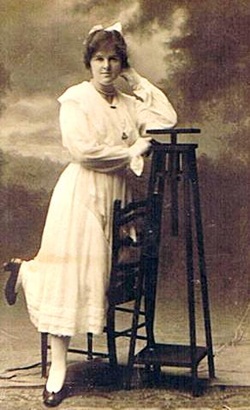
Bridget was the eighth child, and third daughter of John and Mary (nee Scully). She was born at Fernhills on 31 May 1899. Her twin brother (Thomas) died on the day he was born.
It appears Bridget was named after both her grandmother, (Bridget, nee Golding); and her mother Mary; (nee Scully). From a very early age Bridget was known as “Dolly”, and within the family, she was known as “Aunt Dolly”. Later in life, she preferred to be known by her given name of Bridget. In this review she will be referred to as Bridget.
She is recorded among the list of pupils who first attended during the third decade of the Fernhills/Kauana school; (1903-1912). Even at that early stage the school records show her name as Dolly Rabbitt. Like all members of this family, Bridget would have been upset by the death of her mother in 1907, when she was only 7 years of age.
In the booklet "Fernhills/Kauana and District", Bridget Rabbitt is recorded as being the first Post Mistress at the Kauana Post Office. Bridget continued to live in the Fernhills/Kauana area through her teenage years and helped maintain farm and family, particularly while two of her brothers were serving overseas in World War I.
Bridget was a bridesmaid at the wedding of her older sister Nora (Nonie), who married Thomas Ryan at Fernhills in 1918. Also between 1918 - 1921 period, Bridget was involved in the nursing and caring for her younger sister Winifred, who was ill with tuberculosis. At that time this was a very serious illness, and all those in contact with it were at risk. The photograph of Bridget (below left) is thought to have been taken when she was in her late teens or early twenties.
It appears Bridget was named after both her grandmother, (Bridget, nee Golding); and her mother Mary; (nee Scully). From a very early age Bridget was known as “Dolly”, and within the family, she was known as “Aunt Dolly”. Later in life, she preferred to be known by her given name of Bridget. In this review she will be referred to as Bridget.
She is recorded among the list of pupils who first attended during the third decade of the Fernhills/Kauana school; (1903-1912). Even at that early stage the school records show her name as Dolly Rabbitt. Like all members of this family, Bridget would have been upset by the death of her mother in 1907, when she was only 7 years of age.
In the booklet "Fernhills/Kauana and District", Bridget Rabbitt is recorded as being the first Post Mistress at the Kauana Post Office. Bridget continued to live in the Fernhills/Kauana area through her teenage years and helped maintain farm and family, particularly while two of her brothers were serving overseas in World War I.
Bridget was a bridesmaid at the wedding of her older sister Nora (Nonie), who married Thomas Ryan at Fernhills in 1918. Also between 1918 - 1921 period, Bridget was involved in the nursing and caring for her younger sister Winifred, who was ill with tuberculosis. At that time this was a very serious illness, and all those in contact with it were at risk. The photograph of Bridget (below left) is thought to have been taken when she was in her late teens or early twenties.
Bridget married Francis (Frank) Langford, in Christchurch in 1925 and they are shown together in the photograph (above right) thought to have been taken about that time.
After their marriage they lived at Heddon Bush where they had a farm with Frank’s brother for some years. After leaving Heddon Bush they worked on various farms in the Central Southland area where Frank’s interests included working with horses. Later they moved to Dipton where they managed the hotel.
Details of their family of seven are;
Bernadette
Francis John
Brendan (See details in the Appendices)
Richard Patrick
Eleanor Marie Therese
Angela
Miriam
Details of their family of seven are;
Bernadette
Francis John
Brendan (See details in the Appendices)
Richard Patrick
Eleanor Marie Therese
Angela
Miriam
Frank’s interest and involvement with horses included being Clerk of the Course at race meetings in the Southland area.
Bridget’s daughter Eleanor has provided the following recollection of her mother.
“She loved family – unfavouring individuals yet individually favouring each. She liked to keep in contact with all her wider family. She was a power among us all – principled, respected and graciously hospitable.
She talked lovingly of her own family and she knew the sadness of losing her own mother when she was only 7 years old; her much loved younger sister when she was 21, her son Brendan (33) her daughter Miriam (45), her son-in-law Paul (29), her eldest grandson Paul (8), and her much loved husband Frank at age 70 years,
She knew hard and difficult times. When she was about 22 years old, she and a friend went on an excursion to Queenstown. Because of a railway strike her return home was delayed. John, her father, was incensed at her late arrival and banished her from the family home. Eventually the rift was healed for my grandfather spent a lot of time in our house and was cared for dutifully and lovingly by both my parents.
Like so many she lived through years of lean, and coped and managed and created. She was frugal and generous. Her occasional trips to Invercargill rewarded us all with necessities bought from L.B. Millars. She had a timeless love affair with earth and plant so we had a lovely garden and plenty of fruit and vegetables. We had plain fare but plenty.
Our mother was proud of her heritage and farming background. She had an incisive mind, sharpened and whetted and expansive from living. She had a wide and accurate knowledge of the world and was blessed with an open mind happily wedding past and present.
In those later years her eyesight became dim and searching and she kept her hands busy – her mind and legs active. She became the Matriarch – a comforter and a doer and proudly independent until the last three weeks of her life. Bridget was baptised in the Catholic faith and she lived her life committed to Christian living through her faith. She was an inveterate prayer and a staunch defender of Christian principles.”
“She loved family – unfavouring individuals yet individually favouring each. She liked to keep in contact with all her wider family. She was a power among us all – principled, respected and graciously hospitable.
She talked lovingly of her own family and she knew the sadness of losing her own mother when she was only 7 years old; her much loved younger sister when she was 21, her son Brendan (33) her daughter Miriam (45), her son-in-law Paul (29), her eldest grandson Paul (8), and her much loved husband Frank at age 70 years,
She knew hard and difficult times. When she was about 22 years old, she and a friend went on an excursion to Queenstown. Because of a railway strike her return home was delayed. John, her father, was incensed at her late arrival and banished her from the family home. Eventually the rift was healed for my grandfather spent a lot of time in our house and was cared for dutifully and lovingly by both my parents.
Like so many she lived through years of lean, and coped and managed and created. She was frugal and generous. Her occasional trips to Invercargill rewarded us all with necessities bought from L.B. Millars. She had a timeless love affair with earth and plant so we had a lovely garden and plenty of fruit and vegetables. We had plain fare but plenty.
Our mother was proud of her heritage and farming background. She had an incisive mind, sharpened and whetted and expansive from living. She had a wide and accurate knowledge of the world and was blessed with an open mind happily wedding past and present.
In those later years her eyesight became dim and searching and she kept her hands busy – her mind and legs active. She became the Matriarch – a comforter and a doer and proudly independent until the last three weeks of her life. Bridget was baptised in the Catholic faith and she lived her life committed to Christian living through her faith. She was an inveterate prayer and a staunch defender of Christian principles.”
The following gem of family history was written by Bridget personally and has also been contributed to Relatively Rabbitt by Bridget’s daughter; - Eleanor.
“My parents were John Rabbitt and Mary Rabbitt (nee Scully). My paternal grandparents were William Rabbitt and Bridget Rabbitt (nee Goulden).My maternal grandparents were Owen Scully and Norah Scully (nee Henley).
I was born at Fernhills on 31st May 1899. My twin Thomas lived an hour and we were privately baptised by Mrs Murphy (old John’s wife) who gave us the names Thomas and Mary. Later I was conditionally baptised Bridget Mary and my godparents were Thomas Murphy and Bridget Scully (my aunt).I was nicknamed Dolly by my brother Patrick James as I was very small and he thought his mother had a doll too, like his sister Nonie. My sisters and brothers: William, Michael, John, Mary (died at 8months), Eugene (died 13years 11months);-I was at his bedside aged 4 and half years, asleep when he died in Dee Street Public Hospital Invercargill- Norah Anne, Patrick James and Winifred Eleanor born 2 and half years after me .My first memory is of standing in front of a big open fire with a black kettle and a porridge pot hanging up before breakfast. The rest of the family were outside somewhere. I also remember getting a new dress for my 4th birthday from my aunt Bridget. Wearing my new dress, I followed Nonie and Paddy (we were all barefoot) and fell in a lot of mud and then washing in a wee wooden tub in icy cold water outside before going indoors.
At 4 and a half I went with my aunt Bridget to Invercargill for a holiday and stayed for 3 and a half years. My aunt was housekeeping for bachelor brothers in a big house in Don St. I guess I might have been spoilt there as aunt and the brothers were kind to me. During this period I became very familiar with streets, shops, buildings and the Puni Creek gardens. I attended St Mary’s Clyde St (later first Marist school). With my aunt I was at the laying of the foundation stone and also at the opening of the Basilica in Tyne St.
I took my young sister Winnie on a tour of Invercargill on foot. At most she would have been three and half years old. The extent of our tour included, Dee St Hospital, Stead St bridge, all the Puni Creek gardens and Leet St Water Tower and arrived back to Don St. where my mother and father were sick with worry, but greeted us calmly………………”
In their retirement Bridget and Frank lived at Waimate, in South Canterbury, and Bridget died in 1989, at the age of 89.
“My parents were John Rabbitt and Mary Rabbitt (nee Scully). My paternal grandparents were William Rabbitt and Bridget Rabbitt (nee Goulden).My maternal grandparents were Owen Scully and Norah Scully (nee Henley).
I was born at Fernhills on 31st May 1899. My twin Thomas lived an hour and we were privately baptised by Mrs Murphy (old John’s wife) who gave us the names Thomas and Mary. Later I was conditionally baptised Bridget Mary and my godparents were Thomas Murphy and Bridget Scully (my aunt).I was nicknamed Dolly by my brother Patrick James as I was very small and he thought his mother had a doll too, like his sister Nonie. My sisters and brothers: William, Michael, John, Mary (died at 8months), Eugene (died 13years 11months);-I was at his bedside aged 4 and half years, asleep when he died in Dee Street Public Hospital Invercargill- Norah Anne, Patrick James and Winifred Eleanor born 2 and half years after me .My first memory is of standing in front of a big open fire with a black kettle and a porridge pot hanging up before breakfast. The rest of the family were outside somewhere. I also remember getting a new dress for my 4th birthday from my aunt Bridget. Wearing my new dress, I followed Nonie and Paddy (we were all barefoot) and fell in a lot of mud and then washing in a wee wooden tub in icy cold water outside before going indoors.
At 4 and a half I went with my aunt Bridget to Invercargill for a holiday and stayed for 3 and a half years. My aunt was housekeeping for bachelor brothers in a big house in Don St. I guess I might have been spoilt there as aunt and the brothers were kind to me. During this period I became very familiar with streets, shops, buildings and the Puni Creek gardens. I attended St Mary’s Clyde St (later first Marist school). With my aunt I was at the laying of the foundation stone and also at the opening of the Basilica in Tyne St.
I took my young sister Winnie on a tour of Invercargill on foot. At most she would have been three and half years old. The extent of our tour included, Dee St Hospital, Stead St bridge, all the Puni Creek gardens and Leet St Water Tower and arrived back to Don St. where my mother and father were sick with worry, but greeted us calmly………………”
In their retirement Bridget and Frank lived at Waimate, in South Canterbury, and Bridget died in 1989, at the age of 89.
Winifred Eleanor Rabbitt: (1901 - 1921)

Winifred was the tenth and final child of John and Mary (nee Scully) and she was born at Fernhills in 1901. As Mary had a sister in New Zealand named Winifred, it is probable John and Mary named their final child after Mary's sister.
Winifred, (known as Winnie) was their fourth daughter and below is a photograph of her taken when she was about 2 years of age.
Winifred, (known as Winnie) was their fourth daughter and below is a photograph of her taken when she was about 2 years of age.
Winifred would have been just 6 years old when her family was devastated by the death of their mother, in June 1907 at Fernhills. It can be presumed that the care and up bringing of Winifred became a responsibility of the family - particularly her older sisters; Nora and Bridget.
Winifred attended the original school at Fernhills from about 1907 and later when the school was relocated she attended school at the new site.
In the very valuable family group photo, shown below, Winifred is pictured with her father (John 1855 -1941) and all her surviving brothers and sisters. This is the only photo seen of the family group, and can be assumed it was taken for some particular reason. Possibly, as two of the sons (Michael and Patrick), were soon to leave on military service overseas, this was the reason the formal photograph was taken.
Winifred is the young woman standing at the right of the group. The photograph is dated about 1916, which puts Winifred's age at the time, at about 15 years.
Winifred attended the original school at Fernhills from about 1907 and later when the school was relocated she attended school at the new site.
In the very valuable family group photo, shown below, Winifred is pictured with her father (John 1855 -1941) and all her surviving brothers and sisters. This is the only photo seen of the family group, and can be assumed it was taken for some particular reason. Possibly, as two of the sons (Michael and Patrick), were soon to leave on military service overseas, this was the reason the formal photograph was taken.
Winifred is the young woman standing at the right of the group. The photograph is dated about 1916, which puts Winifred's age at the time, at about 15 years.
In the photograph below, Winifred (seated) is shown with her sister Bridget and brother Michael. It is estimated this photograph was taken about 1917 and is probably another example of a formal photograph taken prior to Michael's departure for overseas service in 1917.
Below is a copy of a Christmas card sent by Winifred to her brother Michael, while he was serving in World War I. This dates the card as about 1917/18 and it is also interesting as it provides an example of her handwriting. See appendices for copy of her Class 6 Botany School Book with further examples of her handwriting.
About two years later in 1919, Winifred became ill with tuberculosis and there are stories told of the living arrangements that were made to accommodate her, so that she would have the best of the available sunshine and fresh air. At this stage this was the most that could be done for those unfortunate enough to contract this terrible illness.
In the coming years tuberculosis was to have a major impact on the wider Rabbitt family, and Winifred was among the first within the family to be affected by the illness. Among the stories told of the special arrangements made for Winifred, is that of a special room that was built for her, high on Fernhills, and that this room was able to revolve so as to always take advantage of the available sunshine. (We will probably never know whether this is a story of fact or fiction).
Winifred lost her battle with tuberculosis, when she passed away at Fernhills on 18th August 1921, at the age of 19 years. Her cause of death is given as Phitisis, which was the earlier name given to tuberculosis.
She is buried in the family plot at the Winton Cemetery, along with her mother Mary, sister Mary, and brothers Eugene, and Thomas, who predeceased her.
In the coming years tuberculosis was to have a major impact on the wider Rabbitt family, and Winifred was among the first within the family to be affected by the illness. Among the stories told of the special arrangements made for Winifred, is that of a special room that was built for her, high on Fernhills, and that this room was able to revolve so as to always take advantage of the available sunshine. (We will probably never know whether this is a story of fact or fiction).
Winifred lost her battle with tuberculosis, when she passed away at Fernhills on 18th August 1921, at the age of 19 years. Her cause of death is given as Phitisis, which was the earlier name given to tuberculosis.
She is buried in the family plot at the Winton Cemetery, along with her mother Mary, sister Mary, and brothers Eugene, and Thomas, who predeceased her.
